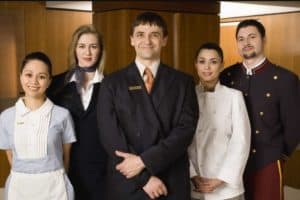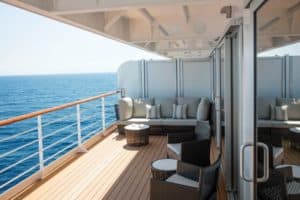Cruise ships are getting bigger, more advanced, and are becoming almost like floating cities. Cruises are big business, so big that it can be hard to wrap our heads around exactly how much they cost to operate.
How much does a cruise ship cost to operate? The cost to operate a cruise ship annually can be several billions of dollars. The Royal Caribbean posted numbers of over 6.1 million passengers who sailed on its ships worldwide in 2018 and have reportedly spent around $9.5 billion on these trips in that same year.
Royal Caribbean had 26 cruise ships in 2018, so the annual operating cost per ship averaged about $360 million per year (or about $1 million per day). The cost will be higher for their larger ships like the Symphony of the Seas and will be less for their smaller ships like the Empress of the Seas.
These operating costs are made up of the following six main expense categories:
- Commissions and transportation expenses
- Onboard expenses
- Payroll expenses
- Food expenses
- Fuel expenses
- Other operating expenses
Advances in technology, materials, and shipbuilding today allow for more substantial and safer ships. These advances translate into more amenities packed into cruise ships.
It has reached a point where a ship is so vast and modern that one would not know that they are inside an actual boat.
Giant swimming pools, shops, casinos, and restaurants can all be found on a cruise ship. Frequently referred to as malls and casinos floating on our oceans, a cruise ship can generate tremendous operating expenses.
Costing upwards of hundreds of thousands of dollars in fuel alone each day, it is a business that needs enormous capital. How are they even making money and profit because of these costs?
Read on to learn more about how much it costs to operate a cruise ship and what makes up that cost.
How Much Does a Cruise Ship Cost to Operate?
It costs more than a cool billion dollars for the biggest cruise ship to be built, and that is just talking about having one built. The annual operating expenses that follow are in a whole league of their own.
Fuel, crew, and maintenance are chief among the main culprits hogging the majority of costs. Cruise ships are built because they are big businesses.
According to the Royal Caribbean annual statement of 2018, the average cruise ship tonnage would be around the size to carry about 3,000 passengers. From the same source, these 3,000 passengers cost on average about $1,252 per person.
A 7-day cruise based on that figure will come up with $536,571 per day as the cost of operating a cruise ship of this size. It is not in any way a massive leap of the imagination to say that the bigger the cruise ship, the higher it costs to operate.
So how much does a cruise ship cost to operate? The Royal Caribbean posted numbers of over 6.1 million passengers who sailed on its ships worldwide in 2018 and have reportedly spent around $9.5 billion on these trips in that same year.
The Breakdown of Cruise Ship Costs
Now that we know the average total annual operating cost, let’s look at the breakdown of this cost. Royal Caribbean Cruises breaks down the total cost into the following six expense categories:
- Commissions and transportation expenses
- Onboard expenses
- Payroll expenses
- Food expenses
- Fuel expenses
- Other operating expenses
1. Commission and Transportation Expenses
These expenses cover expenses generated with passenger tickets, travel agency commissions, and port costs that may vary, depending on the manifest or the number of passengers on the ship.
While it varies, the port cost will usually be calculated around the tonnage and passengers’ number.
The ship’s payment for docking is assimilated into and trickles down along security, terminal electricity costs, and, more importantly, space for loading.
2. Onboard Expenses
Also taken into account are the onboard revenues, like the shops and restaurants aboard the ship itself and the associated costs of operating them. This group of expenses covers the insurance premiums of all insurable items or products in the boat.
Tours conducted before the cruise are also included here. Payments to third-party concessionaires and procurement costs belong here as well. These add up to how much it costs a cruise to operate.
3. Payroll Expenses
Payroll is relatively more straightforward than the others listed here. While hundreds of land-based personnel work for the cruise ship, this group refers to only the staff’s payroll expenses aboard the ship.
The figures here widely vary depending on the size and passenger capacity of the liner involved.
4. Food Expenses
Food expenses cover food for both the crew and the passengers. It can be substantial for larger cruise ships because crews and passengers can total up to 5,000 or more per ship.
Food is one of the largest factors in coming up with cruise ship operating costs. The largest cruise ship floating the seas now, the Symphony of the Seas, lists what their passengers consume for a 7-day cruise:
- 6 million coffee beans for the 1,500 lbs of coffee needed each week
- 9,700 lbs of chicken
- 60,000 eggs
- 15,000 lbs of beef
- 700 lbs of ice cream
- 20,000 lbs of potatoes
- 2,100 lbs of lobster tails
- 12,600 lbs of flour
- 2,500 lbs of salmon
- 5,000 lbs of french fries
- 5,300 lbs of bacon
- 12,000 lbs of flour tortillas
- 2,000 lbs of wings
5. Fuel Expenses
This part of the operating expenses covers the fuel itself’s cost, the cost of delivering it to the ship, and the added expenses incurred for storage. Tonnage and speed are significant factors on how much a cruise ship will need for fuel, and the consumption is directly proportional to these figures.
On average, a large cruise ship on normal speed will consume about 250 tons of fuel per day. At around $500 per ton, we arrive at $125,000 per day as the fuel cost.
6. Other Operating Expenses
Other operating expenses for cruise ships include: maintenance, repairs, and similar operating costs belong to this category. Insurance for the vessel is another big operating expense to be accounted for.
Check out the below video, which shows the costs that go into operating Royal Caribbean’s Oasis of the Seas cruise ship:
Also, if you plan on taking a cruise vacation, an inflatable paddle board is perfect for when you’re docked:
Click here to see it on Amazon.
Is There Still Enough for Profit?
The cost of operating a cruise ship is staggering, to say the least, and makes one wonder if there is still enough left for profits. Based on the numbers released and made public by the Royal Caribbean on their annual statement, it is quite lucrative.
For the average $1,560 revenue generated by each passenger, 19.1% or $298 ends up as profit for the company.
They declared a $1.815 billion profit in last year’s operation, which translates to $4.96 million per day. With these figures, a resounding yes would be the answer to the question of whether there would still be enough for profit. Of course, these figures may be higher.
We cite Royal Caribbean ships here as they operate three of the largest cruise ships ever built and among the most advanced and fully equipped.
They represent the pinnacle of what the cruise line industry can achieve. They also represent the best on how we can wrap our heads around the massive amounts needed to operate these massive luxury ships.
A cruise ship is costly to operate per day, and that is the obvious bottom line. The rewards are great, too, but schedules are followed to the minute to keep it that way.
Every second counts when talking about hundreds of thousands of dollars in operating costs daily. This is where the phrase ‘running a tight ship’ comes from. To make sure profit remains optimal, the strategy above is the only way to do it.
Cost to Build a Cruise Ship
In addition to the operating costs, cruise ships look to pay back the initial cost of building the ship. So it is important to take a look at how much it costs to build the ship in the first place.
A small-sized cruise ship that holds only about 500 passengers might cost around $250 million to be built. The bigger a cruise ship gets, the more massive its operating budget becomes.
The price goes up from the $250 million figure as the number of passengers or the cruise ships’ capacity goes up. A passenger cruise ship that can accommodate 2,000 to 3,000 passengers costs about $500 million to build.
At present, the largest cruise ships that can carry about 4,000 to 5,000 passengers cost about $1 billion to be built. Anything more than a 5,000-people capacity will exceed $1 billion to be built.
The largest cruise ship in the world, The Harmony of the Seas, cost a staggering $1.35 billion to be built. The vessel has 2747 cabins and even has its own Starbucks cafe.
With the ship’s crew and the passengers combined, there would be around 7,000 people on board. For comparison, US Aircraft carriers are crewed by about 5,000 people.
However, it is not just the size that dictates the pricing; several other factors come into play. Cruise ships are not only passenger ships; these ships are built primarily to be floating entertainment centers.
Some are even developed more to be more like a floating casino rather than carry passengers.
One of the factors that determine the cost to build a cruise ship is what kind of amenities are included. Restaurants, casinos, game rooms, or even the entirety of any land-based five-star hotel are all transported inside these giant floating cities.
Conclusion – Cost to Operate a Cruise Ship
So, to recap, how much does a cruise ship cost to operate? Cruise ships can cost several billions of dollars to operate annually. Royal Caribbean spent a whopping $9.5 billion in all of 2018.
Royal Caribbean had 26 cruise ships in 2018, so the annual operating cost per ship averaged about $360 million per year (or about $1 million per day).
The cost will be higher for their larger ships like the Symphony of the Seas and will be less for their smaller ships like the Empress of the Seas.
The cost comes from the following six expense categories:
- Commissions and transportation expenses
- Onboard expenses
- Payroll expenses
- Food expenses
- Fuel expenses
- Other operating expenses
After learning about the costs, it might make more sense when you hear the shocking ticket price of some of these cruises. They have to pay for the full experience somehow.
As cruises get larger and more luxurious, it is a sign there are more and more people willing to fork over the cost of the higher ticket prices. And there are always discounts and promos to be found if you search for them!
Related reading:
How Much Does It Cost to Live on a Cruise Ship?
What Is the Newest Royal Caribbean Cruise Ship?



![Freedom Boat Club Cost [Freedom Membership Cost and Review] freedom boat club cost](https://boatinggeeks.com/wp-content/uploads/2021/07/freedom-boat-club-cost-150x150.jpg)





